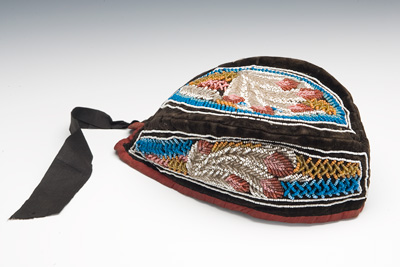Fur Trade Collections in Scotland
Many men who worked in northern Canada for fur trade companies sent examples of Aboriginal artwork and technology to friends and relatives, or brought them home with them when they retired. Some of these items were sent as scientific curiosities and were intended to show the skills or perceived cultural difference of Aboriginal people. Others were more personal items, for instance locally made clothing designed to suit the challenging physical environment. Though many artefacts were sent directly to museums by men in the fur trade, others have since been donated to collections by their descendents.

The Stromness Museum displays many artefacts relating to the connections between the Orkney Islands and the Hudson's Bay Company.
©Photograph by Alison Brown
Many items in Scottish museums are undoubtedly connected with the fur trade but little documentation to clarify their origin has survived. In other cases, rich possibilities exist for exploring social relationships using artefacts as a focus, for example, by thinking about the lives and experiences of the people who made them and the routes through which they came to be in collections. One of the earliest recorded donations of a collection sent by a Scots fur trader to a Scottish museum is that of Colin Robertson , who sent a box of artefacts, mostly collected by his protégée, James Murray Yale, to the Perth Literary and Antiquarian Society in 1833. Robertson referred to the collection as “a few curiosities collected on the shore of the Columbia and the surrounding countries about the Rocky Mountains”, and it includes Coast Salish, Haida and Tlingit material as well as a beaded Glengarry hat, probably collected by Robertson himself near his home in Montreal.

Beaded Glengarries combined the style of Scots military headgear with the skills of Haudenosaunee seamstresses in the Great Lakes region. This one was bought by Colin Robertson.
© Courtesy of Perth Museum & Art Gallery, Perth and Kinross Council. 1978.766
National Museums Scotland has the largest collection of Aboriginal materials in the country, and many of these pieces are connected to fur trade employees. Andrew Graham, who worked for the Hudson’s Bay Company at Churchill, York Factory and Severn between 1749-1775, for example, donated a number of Cree artefacts as well as natural history specimens to the museum of the Royal Society of Edinburgh. Some of these pieces are now in the collection of National Museums Scotland. During the 1850s, Hudson’s Bay Company employees, including James Hargrave, Bernard Rogan Ross and Robert Campbell amongst others, responded to a call to collect for the Industrial Museum of Scotland, the former name of the National Museum of Scotland. The materials they collected included clothing, tools, domestic items and hunting equipment from Inuit, Tlicho, Slavey and Gwich’in peoples. In 2006 National Museums Scotland loaned many Northern Athapaskan items to the Prince of Wales Northern Heritage Centre in Yellowknife, Northwest Territories, for an exhibition called Dè T’a Hoti Ts’eeda – We Live Securely by the Land and for outreach activities with local communities.

Children of the Jean Wetrade Gameti School, Gameti, looking at a dog harness and sled lines from the NMS collections.
© Copyright Wendy Stephenson, PWNHC
Throughout the nineteenth and twentieth centuries, National Museums Scotland has continued to acquire material from Scots Hudson’s Bay Company employees and their descendents. These include Orcadian Lorenz Learmonth (1892-1985), who worked at remote posts throughout the Northwest Territories and Labrador for 46 years, and whose photographic collections are housed at the Prince of Wales Northern Heritage Centre; John Clark whose family donated beadwork and silk embroidery he collected while working as a clerk for the Hudson’s Bay Company in northern Quebec in the 1870s and Alexander Naismith Mouat (1863-1950), who had worked as an inspecting officer for the Hudson’s Bay Company during the late nineteenth and early twentieth centuries, and who collected Aboriginal artefacts from across western Canada.
At Aberdeen University’s Marischal Museum, there are several collections which were donated to the museum by Hudson’s Bay Company men. In addition to the mid-twentieth collection of carvings and textiles assembled by Captain William Mitchell while sailing on Hudson’s Bay Company ships along the Northwest Coast, the museum is especially rich in materials collected by Hudson’s Bay Company men posted to the eastern Arctic in the early twentieth century. These include Aberdonian John Livingstone’s extensive collection of Inuit carved ivory animals, tools and fishing and hunting equipment and that of his contemporary, William R. Mitchell. Further information on these three collections can be found on Marischal Museum’s on-line database.
The many connections of Orkney Islanders and the Hudson’s Bay Company are explored in the Stromness Museum, which features displays on the life and career of Dr. John Rae, one of the most prominent Orkney men to join the Company in the nineteenth century, as well as other Orcadians, such as James Sinclair and William Watt. These displays also feature the continuing links between families of Orcadian and Aboriginal descent.
Most of Scotland’s museums with World Cultures materials have some artefacts in their collections that are traceable to the fur trade. Many other items remain in family homes as heirlooms and mementoes of an ancestor’s working life overseas. This website brings together examples of museum and family collections to illustrate the rich resources for exploring fur trade and Aboriginal histories in Scotland.


